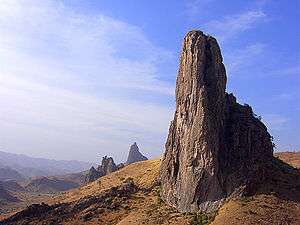Volcanic plug
A volcanic plug, also called a volcanic neck or lava neck, is a volcanic object created when magma hardens within a vent on an active volcano. When present, a plug can cause an extreme build-up of pressure if rising volatile-charged magma is trapped beneath it, and this can sometimes lead to an explosive eruption. Glacial erosion can lead to exposure of the plug on one side, while a long slope of material remains on the opposite side. Such landforms are called crag and tail. If a plug is preserved, erosion may remove the surrounding rock while the erosion-resistant plug remains, producing a distinctive upstanding landform.
An example of two volcanic plugs can be found at the Pitons, in Saint Lucia, as they rise abruptly out of the eastern Caribbean Sea.
Examples of volcanic plugs
In Africa
Near the village of Rhumsiki in the Far North Province of Cameroon, Kapsiki Peak is an example of a volcanic plug and is one of the most photographed parts of the Mandara Mountains. Spectacular volcanic plugs are present in the center of La Gomera island in the Canary Islands archipelago, within the Garajonay National Park.
In Europe
Borgarvirki is a volcanic plug located in north Iceland.
A volcanic plug is situated in the town of Motta Sant'Anastasia in Italy.
Saint Michel d'Aiguilhe chapel, whose construction started in 969,[1] near Le Puy-en-Velay in France. The volcanic plug rises about 85 metres (279 ft) above the surroundings. Another building on a volcanic plug is the 14th century Trosky Castle in the Czech Republic.
Strombolicchio, the northernmost of the Aeolian Islands, and Rockall, a small, uninhabited, remote islet in the North Atlantic Ocean, are also volcanic plugs.
In the United Kingdom, two examples of a building on a volcanic plug are the Castle Rock in Edinburgh, Scotland, and Deganwy Castle, Wales. The Law, Dundee, Ailsa Craig, Bass Rock, North Berwick Law and Dumgoyne hill are other examples of volcanic plugs located in Scotland. There are over 30 volcanic plugs in Northern Ireland, including Slemish in Ballymena, Tievebulliagh, Scawt Hill, Carrickarede, Scrabo and Slieve Gallion.[2]
In North America
Examples of volcanic plugs in the United States include Morro Rock, California and Laurel Hill, New Jersey. Devils Tower in Wyoming, as well as Little Devils Postpile located in Yosemite National Park, are also thought to be a volcanic plug by many geologists. Geologists in the early 1900s thought that an example of a volcanic plug in the eastern USA is the highly eroded Stark's Knob basaltic structure located along the Hudson River near Saratoga Springs, New York. However, today, geologists believe Stark's Knob is not a plug at all, but merely an outcrop of an ancient submarine lava flow.
The origin of Devils Tower (featured in the 1977 movie Close Encounters of the Third Kind) is not totally clear. Although it is generally admitted that it was formed by igneous intrusion, it is not necessarily a volcanic plug, formed within the vent of an active volcano.
In New Mexico, Shiprock is a further example.
The Pitons of Saint Lucia, in the eastern Caribbean Sea are two volcanic plugs that rise abruptly out of the sea and are part of a UNESCO World Heritage site. The highest mountain plug rises to a height of nearly 760 metres (2,490 ft).
In Canada, the Castle Rock, located in British Columbia, is a volcanic plug that had volatile-charged magma still beneath it, leading to a Volcanic Explosivity Index 2 eruption.
In Oceania
New Zealand
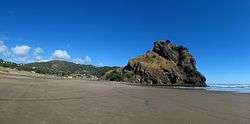
There are several volcanic plugs in the North Island of New Zealand, including:
- the Pinnacles in the Coromandel Peninsula
- Bream Head in Northland
- Paritutu and the adjacent Sugar Loaf Islands in Taranaki
- St. Paul's Rock at Whangaroa Harbour
- Piha's Lion Rock, which hosted a fortified Maori pa.
In New Zealand's South Island, Ōnawe Peninsula on Banks Peninsula is a prominent volcanic plug, and erosion of Saddle Hill near Dunedin has also revealed a plug. Dunedin's Mount Cargill displays two plugs: its main summit and the subsidiary summit of Buttar's Peak.
Australia
In Australia, the Nut[3] and Table Cape in Tasmania are further examples along with Mount Warning in New South Wales.[4]
Gallery
| Wikimedia Commons has media related to Volcanic plugs. |
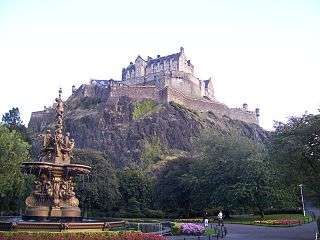
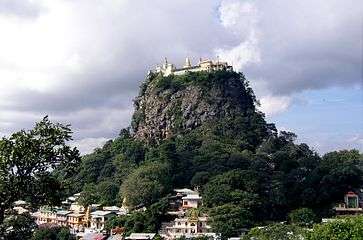 Taung Kalat, Burma.
Taung Kalat, Burma.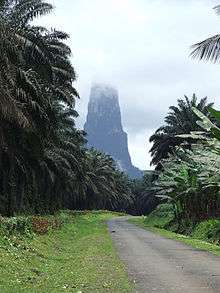 Pico Cão Grande, landmark volcanic plug peak on São Tomé Island (São Tomé and Príncipe), rising over 300 metres (980 ft) above the surroundings.
Pico Cão Grande, landmark volcanic plug peak on São Tomé Island (São Tomé and Príncipe), rising over 300 metres (980 ft) above the surroundings.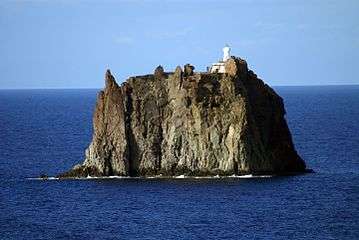 Strombolicchio Island and its lighthouse, close to Stromboli Island (Aeolian Islands, Italy).
Strombolicchio Island and its lighthouse, close to Stromboli Island (Aeolian Islands, Italy).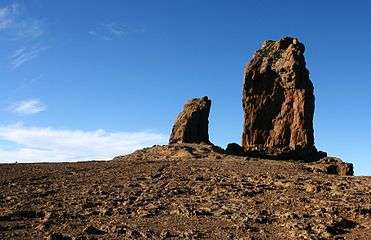 Roque Nublo, symbol of Gran Canaria island.
Roque Nublo, symbol of Gran Canaria island. Dent de la Rancune, a challenging climbing site in the Chaîne des Puys, France.
Dent de la Rancune, a challenging climbing site in the Chaîne des Puys, France._-_geograph.org.uk_-_834986.jpg)
- Trosky Castle ("Panna" Tower), Czech Republic.
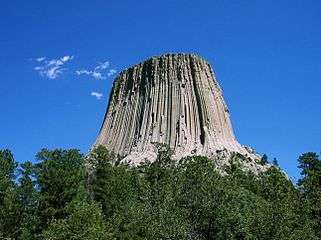 Devils Tower, Wyoming, USA.
Devils Tower, Wyoming, USA.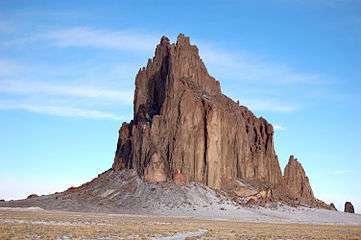 Shiprock, New Mexico, USA.
Shiprock, New Mexico, USA.- St. Paul's Rock, above Whangaroa Harbour, Northland, New Zealand.
References
- ↑ "Eglise Saint-Michel". Monuments historiques (in French). Société Française d'Archéologie et Ministère de la Culture (France). 27 June 2006. Retrieved 30 June 2013.
- ↑ Wilson, H E et al (1986) Geological Survey of Northern Ireland, HMSO
- ↑ "The Nut, Stanley". Discover Tasmania. Government of Tasmania. 2011. Retrieved 30 June 2013.
- ↑ "Wollumbin/Mt Warning Shield Volcano". Geological sites of NSW. Cartoscope Pty Limited. Retrieved 30 June 2013.
